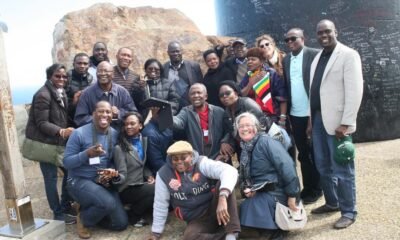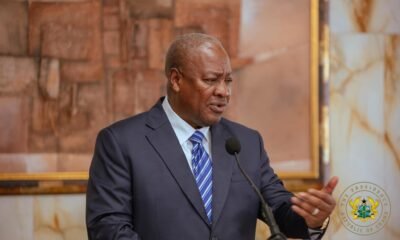Profile
Meet Mavis Adjoa Yeboah Adjei, brain behind leading clothing giant

Gone were the days when people gave little attention to what they wore for public functions.
One’s fashion sense has become a big deal in recent time with the use of social media taking the fashion craze a notch higher.
At some high profile entertainment events with red carpet receptions, one often hear a harmless question like, ‘what are you wearing,’ which in effect means the identity of the creator of one’s dress.
Fashion lovers have been very alert to this, and in the process become very choosy and careful about what they wear out.

This, therefore, requires a vibrant industry, driven by hardworking designers to meet the increasing demands for such designs.
One of such persons making giant strides and amazing designs for the past 14 years is Mavis Adjoa Yeboah Adjei , a visionary CEO and Creative Director of Adjoa Yeboah Clothing.
Mrs Adjei ventured into fashion designing after giving her cloth to a seamstress to work on for a programme, only to be disappointed on the D-day.
“I was frustrated because I didn’t have anything to wear. Through my frustration, I decided to enroll at the Joyce Ababio College of Fashion. After that I launched my business,” she narrated to The Spectator.
“I’ve always believed in nurturing one’s passion. My love for fashion and design led me to pursue formal education at the Joyce Ababio College where I honed the skills necessary to turn my passion into a thriving business,’ she indicated.

The old student of Ghana Secondary School, Koforidua, says she has this desire to provide a unique blend of fashion outfits in order to satisfy the variegated tastes of a myriad of clientele.
Adjoa, as she is affectionately known, was inspired by colours and considered the body type of clients before making an outfit for her clients.
And her biggest aspiration was to be the number one in the industry, providing bespoke clothing solutions to the generality of mankind as they step into the world of work and social network interactions/ programmes with unparalleled confidence and elegance.

Adjoa’s designs have been worn by both national and international celebrities, including Anita Akuffo, Korkui Salormey, Dentaa Amoateng and Rosalyn Felli, just to mention a few.
Despite the busy schedule with work, Adjoa, a mother of four, carefully plans her activities in order to meet the demands of family life as well.
“I prioritise my time, ensuring that I’m fully present in both my professional and personal life. My family’s support has been crucial in helping me manage these responsibilities, allowing me to excel in both areas.”



As a result, she has become a mentor to hundreds of successful fashion designers and is a crucial resource for industrial attachment and internship for students studying fashion, textiles, and garment studies at both public and private universities.
Awards
Adjoa Yeboah Clothing was honoured as the Fashion Brand of the Year at the 2019 Women’s Choice Awards due to her outstanding leadership and stellar delivery of fashion outfits in the year under review.
Furthermore, her clothing line has collaborated with Media General/ TV3’s flagship culture and entertainment show ‘Ghana’s Most Beautiful’ as the fashion hub of choice.
She also collaborated with esteemed national and international personalities and fashion brands such as Vlisco (including the Vlisco Ambassador project) to outdoor many spectacular product collections.
Adjoa worked with Vlisco as a fashion designer in 2014 where she designed and clothed Vlisco’s Ambassadors.
She also curated looks for other Vlisco influencers as well as those for Vlisco Radiance Bridal fair. In 2017, she partnered and unveiled Vlisco Capsule Collection in the flagship store at Accra Mall.
Challenges
Like any entrepreneur, she faces challenges, particularly in balancing creative innovation with the daily management of the business. Earlier on, she saw the need for more training to manage the operational side of the brand, which led her to pursue further studies in management.
Again, she was affected gravely by the high cost of production (ie materials, power, and accessories) which affects the cost of the final product.
Aspirations
Adjoa aims to position her clothing line as a globally recognised brand that continues to empower women and inspire the next generation of designers.
She also want to continue advocating for the empowerment of women and children, using her platform to make a positive impact.
Education
She pursued a management degree at the Ghana Institute of Management and Public Administration (GIMPA) to enhance her business skills, and also completed the Women Entrepreneurship and Leadership Africa (WELA) Programme at the China Europe International Business School to learn how to position the brand for global success.
Hobbies
Adjoa Yeboah loves listening to a blend of soul, jazz and traditional music, and likes to travel to the countryside to enjoy nature as a source of inspiration. She also loves to read and watch latest trends in the world of fashion.
Born to Mr George Adjei Anobi and Madam Faustina Kyeremaa, she is the first among four siblings – (three girls and a boy) and hails from Berekum in the Bono region.
Advice
Adjoa wants the youth to focus on what they’re passionate about and dedicate time and resources to mastering their skills. Excellence doesn’t happen overnight—it’s a result of consistent effort and learning.
By Linda Abrefi Wadie
Profile
Patriotism, sacrifice and service — the veterans’ perspective
For men and women with battlefield experience, patriotism, sacrifice, and service are not just abstract ideas, they are lived experiences deep-rooted in hardship and sustained endurance in the line of duty.
Such lifelong duty goes beyond the uniform to include the values of duty, honour, and commitment, long after active military service.

Such has been the life of Ex Lance-Corporal Wisdom Edmund Kudowor, a 97-year-old World War Two (WWII) Veteran, who volunteered for recruitment in 1943 at the age of 15.
He was to be trained and enrolled as a soldier and tradesman for the Artisan Work Company of the then Gold Coast Regiment.
Though looking frail currently after a few days of head surgery, the ex-serviceman’s ability to recall his past experiences was exceptional.
Ex-Lance-Cpl Kudowor lived in an era that saw many young Africans recruited and conscripted to fight for their colonial masters in a war that ravaged half of Europe and claimed almost 85 million lives.
In a brief yet straight to the point interaction with the Ghana News Agency, he expressed no regret in volunteering, despite the imminent danger and harrowing stories about WWII back then.
More surprising was his nonchalant attitude towards the fact that he was not put on pension immediately after service. He expressed no bitterness nor pain.
He returned to the Gold Coast in 1946 after four years of service without any benefits, not until two years ago when he began receiving an annually paid British grant, which was recently increased to 1,350 pounds sterling.
Though the grant did not match the sacrifice, “it is still better than nothing,” he said. Despite his past experiences, the old veterans’ patriotism, sacrifice and service did not wane after his return in 1946, at age 18, to the then Gold Coast.

He gained scholarship to further his education (both home and abroad) and with the knowledge acquired, he served his country for almost half a century, first as a pupil teacher, and rising to become the Headmaster of the Kpando Technical Institute. He headed other educational institutions and retired as a civil servant.
The veteran was not happy about the decline in patriotism and sacrifice, especially among young people in contemporary Ghana.
Listening attentively due to a hearing challenge, the frail-looking veteran pointed to the attitude of the current generation, most of whom were unwilling to go the extra mile to support their country.
He expressed worry over their focus on immediate gains and monetary rewards for little services rendered.
His observation was corroborated by Captain Ben Edmund Duah (Rtd), a veteran, who began his service with the Field Engineer Regiment soon after being commissioned at age 24 as a young officer in the early 1970s.
The retired Army Captain, who once served with the Delta Company of the Five Battalion of Infantry (5BN) among other positions, said: “Patriotism is non-existent in today’s Ghana, unlike our time when we took pride in openly exercising these values.” He, however, did not entirely blame the youth for not exhibiting such traits.
Capt. Duah (Rtd) attributed the seeming non-patriotism by the youth to the struggles they see the veterans go through just to survive, after sacrificing for humanity.
The needs and concerns of patriots and forerunners, particularly veterans in Ghana, were largely unmet, compared to other countries, he said.
“The veterans brought honour to our colonial masters and by extension to Ghana. They were not given what they were promised. Right now, the British Government gives them some support and that is what sustains a lot of them.” Captain Ben Duah stressed the urgency for the country to pay more attention to the concerns and needs of veterans.
“We should see them as people who voluntarily decided to sacrifice their lives for us. If anybody does this for you, you should be fair enough to look at his interest…these are people who have devoted their lives to save us, therefore we should be nice to them in the form of caring for them,” he noted.
When asked for their opinion on many of the youth trying to seek greener pastures abroad due to their lack of confidence in the economy, Capt Duah and L/Cpl Kudowor both agreed that Ghana was still worth sacrificing for, despite the challenges.
Captain Duah, who served during an era awash with military coups d’etats, urged Ghanaians to respect, recognise and be willing to support veterans because government could not shoulder the responsibility alone.
“Citizens should realise that these are people who, some time ago, in their youthful years, sacrificed their precious lives to save others…We expect that as veterans, people will respect and admire them for their values and bravery,” he said.
“I will advise the youth to utilise existing opportunities as a means to serve Ghana. Service to the country, I believe, should be the youths’ primary goal”, Ex L/Cpl Kudowor said.
The two justified the continuous celebration of Veterans Day on the 28 of February as a step in the right direction.
This serves as a platform for the youth to learn about the three values of patriotism, service and sacrifice, the history behind the celebration and the need to respect veterans.
On February 28, 1948, Veterans of World War II, who had fought with the Gold Coast Regiment of the Royal West African Frontier Force, organised a peaceful demonstration, marching to the Christainborg Castle at Osu in Accra, the capital of the Gold Coast, to hand a petition to the colonial governor, demanding their end of war benefits, which they had been promised.
Before reaching the castle, the veterans were ordered to disperse by the colonial police chief. When they refused, he opened fire on them, instantly killing three of the ex-servicemen – Sergeant Adjetey, Corporal Attipoe, and Private Odartey Lamptey.
The 28 February Crossroads Shooting is commemorated every year to honour the veterans for their sacrifice to the country.
—GNA
Profile
Prisca Abah: Ghana’s modelling powerhouse

Ghanaian model, philanthropist and advocate, Prisca Abah, who is known for her contributions to the fashion industry, is strutting her stuff on higher levels.
She was recently selected as one of the models for the Big8 Girls Project, an initiative by Clinton Samuel to celebrate influential African models.
The project consisted of three episodes: the Bio Shoot which highlighted Abah’s professionalism through a corporate-themed photoshoot; Afrodeity which focused on showcasing her confidence and artistry, celebrating the African divine feminine and royalty which presented Abah as a symbol of African cultural pride, embodying strength and elegance.

The Big8 concept, produced by Clinton Samuel, intentionally highlights and celebrates the strongest and most influential models on the African continent, congratulating their steadfastness and contributions to the African fashion industry, even as they grind and win in other aspects of life.
The Big8 sets hierarchy and high standards in the African fashion and modelling industry, crowning eight of them with the ‘Top Model’ status as the leading female models in Ghana at the moment.
“Working with these fiery women will surely ignite more creative minds and stir the pot of positive competition,” said Clinton.

Abah’s early life and career
Prisca Abah began her modelling career in 2013, achieving her first notable milestone in 2014 with an editorial shoot for 5-Star International Modelling Agency. In 2015, she made her runway debut at the Ghana Fashion Awards.
From 2016 to 2018, Abah participated in major African fashion events such as Glitz Africa Fashion Week, Mercedes-Benz Fashion Week in Johannesburg, and Rhythms on the Runway.
During this period, she received accolades, including the “Best Female Model of the Year” and spoke as a UN Ambassador for Sustainable Development Goal 12 at the Sustainable Rice Platform Conference.
International recognition and pageantry
In 2022, Abah expanded her reach by entering the pageantry world. She placed as the first runner- up at the Beauty of Africa International Pageant and represented Ghana at the Miss Globe World Finals, where she earned the title of Miss Globe Africa 2022.

Philanthropy
Abah founded the Palins Foundation, a non-profit organisation, aimed at empowering women and youth through initiatives in education, skills training, and personal development.
Awards and collaborations
In 2023, Abah received the Best Model of the Year award at the Time Ghana Arts and Entertainment Awards. She has collaborated with leading designers such as Charlotte Prive and Ejiro Amos Tafiri, further solidifying her influence in African fashion.
Legacy
Prisca Abah is recognised not only for her contributions to the fashion industry but also for her philanthropic efforts. Her journey serves as an inspiration to young Africans, encouraging them to pursue their dreams while giving back to society.
By Edem Mensah Tsortorme















